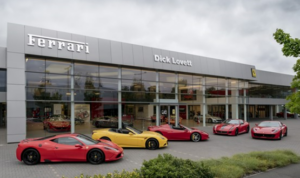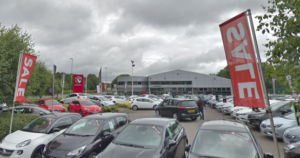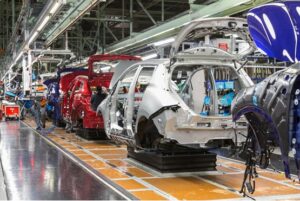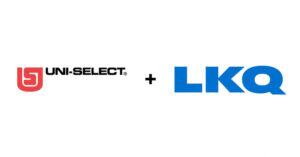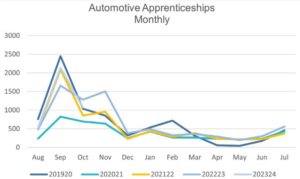
Following a pivotal few months for the automotive sector, Greg Cox, director at FRP Corporate Finance, assesses the current challenges facing operators and how is this driving change and impacting deals in the industry.
The automotive sector – along with wider UK industry – has navigated a plethora of economic and supply challenges in the past 12 months.
Despite this, demand for new vehicles remains strong. New registrations rose for a 15th consecutive month in October, with electric vehicle (EV) registrations for the year set to surpass the number registered in the whole of 2022 with another six weeks of 2023 to spare.
However, with headwinds continuing to persist and a number of new trends developing, the sector is at an important juncture.
Bumps in the road
High interest rates have significantly shaped the UK economy over the past 12 months. This has had a pronounced impact on consumer purchasing confidence for big ticket items and, while sales have remained strong, the cost of paying for them on finance has increased. Perhaps tellingly, used car prices have fallen month-on-month for the past two months, suggesting tightening belts amongst average earners.
Surging input costs have exacerbated this issue for dealerships. Car dealership showrooms can be expensive to run at the best of times, demanding lighting, heating, and air conditioning costs, regardless of footfall and sales. Inflation may now be falling, but its impact is still prevalent. Many operators will have noted increasing pressure on their bottom lines throughout the past six months – especially independent operators, who do not benefit from the economies of scale afforded to larger rivals.
Compounding this, dealers have also had to negotiate updated FCA (Financial Conduct Authority) regulation and Consumer Duty rules. Introduced on 31st July this year, the new regulatory framework effectively demands that finance providers prove that their services deliver fair value for customers. While 97% of car dealers feel confident in the financial services they provide to customers, compliance costs will have chipped into the already thin margins that many dealers operate on.
The journey ahead
Against this backdrop, dealerships have also had to contend with the costs associated with operating in a sector going through rapid change.
Much ink has been spilled chronicling the challenges of the UK transitioning to EVs and the investment that it will require. Concerns may have been eased slightly by the Government’s earmarking of £2bn for investment in the zero-emissions automotive sector as a part of the Autumn Statement. However, it remains costly for dealerships to develop an infrastructure that allows them to sell these vehicles, including implementing charging points to ensure customers are able to test drive vehicles etc.
How they service cars will also change significantly, as EVs do not require the same in-depth maintenance as petrol or diesel vehicles. Instead, garages and dealerships will have to focus on servicing elements that will remain in high demand, such as brakes and tyres which may wear quicker in EVs.
The Government’s recent decision to push back on the ban of internal combustion engine vehicles to 2035 will have created breathing room for those toiling to support the initial 2030 deadline. However, both manufacturers and dealerships alike will be hoping that this doesn’t lead to a drop off in appetite for EVs amongst private buyers.
On top of economic pressures and EVs, technology is causing a huge shift in consumer behaviour and selling models. Indeed, the sector is becoming increasingly digitalised. Highly connected consumers and new digital technologies are driving dealers to embrace an omni-channel experience as consumers place greater value on information and convenience. Similarly, third-party price comparison channels – such as Autotrader – are increasing vehicle pricing transparency and enabling consumers to make product comparisons. This has limited the influence of dealers over consumer buying behaviour, making it more difficult to capture margins on each sale.
It would be remiss not to also mention the continuing impact of the agency model, where manufacturers remain an essential part of the decision making process for selling a car, controlling the pricing, information and contract element of the value chain (with an ‘agent’ / dealer managing the physical handover of the vehicle and test drives etc). The challenge for dealers is that this model typically results in lower margins as they receive a fixed fee for each transaction and no longer have influence over pricing.
Future success will depend on the dealers’ ability to adapt to this changing climate. For those looking to stay ahead of the curve, there are a host of options to deliver future profitability and growth.
Driving activity
It’s no secret that increasing numbers of dealerships are coming up for sale, a trend that’s creating opportunities for both bigger and smaller players alike.
Upscaling through acquisition can not only help elevate a dealer’s market presence, but it can also allow smaller dealers to pool resources and develop economies of scale. As well as reducing the risk posed by challenging market conditions through diversification into related products (e.g. leasing / hire, used vehicles) or product add-ons (e.g. insurance), this can help to protect margins and diversify the dealer away from reliance on OEM bonuses.
For those not willing to engage on their own acquisition process, exit options remain robust with strong UK trade appetite and overseas buyer interest. Recent years have seen UK-based automotive retail businesses valued significantly lower than their international alternatives despite delivering strong returns. When combined with a relatively cheap pound and potential future currency upside, this is making UK automotive retail an increasingly attractive investment proposition.
As the automotive retail landscape continues to evolve rapidly, those operators that choose to adapt their dealership models – be it through M&A, an injection of capital or a restructuring of operations – will be best placed to flourish amid this sea of change.
- SEO Powered Content & PR Distribution. Get Amplified Today.
- PlatoData.Network Vertical Generative Ai. Empower Yourself. Access Here.
- PlatoAiStream. Web3 Intelligence. Knowledge Amplified. Access Here.
- PlatoESG. Carbon, CleanTech, Energy, Environment, Solar, Waste Management. Access Here.
- PlatoHealth. Biotech and Clinical Trials Intelligence. Access Here.
- Source: https://www.am-online.com/opinion/2023/12/20/executive-view-assessing-the-automotive-retail-landscape
- :has
- :is
- :not
- :where
- $UP
- 12
- 12 months
- 2022
- 2023
- 2030
- a
- ability
- Able
- acquisition
- adapt
- afforded
- agency
- ahead
- AIR
- Air Conditioning
- alike
- allow
- allows
- along
- already
- also
- alternatives
- Amid
- amongst
- an
- and
- Another
- appetite
- ARE
- AS
- assesses
- Assessing
- associated
- At
- attractive
- authority
- automotive
- Autumn Statement
- average
- away
- back
- backdrop
- Ban
- BE
- becoming
- been
- behaviour
- benefit
- BEST
- Big
- bigger
- bonuses
- both
- Bottom
- breathing
- businesses
- but
- BUYER..
- buyers
- Buying
- by
- CAN
- capital
- capture
- car
- cars
- causing
- chain
- challenge
- challenges
- challenging
- change
- changing
- channels
- charging
- cheap
- Choose
- Climate
- combined
- coming
- comparison
- comparisons
- compliance
- Concerns
- conditions
- Conduct
- confidence
- confident
- connected
- consecutive
- consumer
- Consumers
- continues
- continuing
- contract
- controlling
- convenience
- Core
- Corporate
- corporate finance
- Cost
- costly
- Costs
- Cox
- created
- Creating
- Currency
- Current
- curve
- Customers
- deadline
- dealer
- Deals
- decision
- Decision Making
- deliver
- delivering
- Demand
- demanding
- demands
- depend
- Despite
- develop
- developing
- diesel
- difficult
- digital
- Digitalised
- Director
- diversification
- diversify
- do
- Doesn’t
- drive
- drives
- driving
- Drop
- e
- each
- Economic
- economies
- Economies of Scale
- economy
- effectively
- Electric
- electric vehicle
- element
- elements
- ELEVATE
- embrace
- enabling
- engage
- Engine
- ensure
- especially
- essential
- etc
- EV
- evolve
- evs
- executive
- Exit
- expensive
- experience
- facing
- fair
- Fallen
- Falling
- FCA
- fee
- feel
- few
- finance
- financial
- Financial Conduct
- Financial Conduct Authority
- financial services
- fixed
- flourish
- Focus
- For
- Framework
- from
- future
- going
- greater
- Growth
- had
- Handover
- Have
- headwinds
- help
- High
- highly
- hire
- hoping
- host
- How
- However
- HTTPS
- huge
- Impact
- impacting
- implementing
- important
- in
- in-depth
- Including
- increased
- increasing
- increasingly
- independent
- industry
- inflation
- influence
- information
- Infrastructure
- initial
- input
- instead
- insurance
- interest
- Interest Rates
- internal
- International
- into
- introduced
- investment
- issue
- IT
- items
- ITS
- journey
- jpg
- July
- juncture
- landscape
- larger
- lead
- leasing
- Lighting
- Limited
- lines
- longer
- looking
- lower
- M&A
- maintenance
- make
- Making
- managing
- Manufacturers
- many
- margins
- Market
- market conditions
- May..
- mention
- model
- models
- Month
- months
- more
- New
- no
- noted
- now
- number
- numbers
- october
- of
- off
- Omni-Channel
- on
- only
- operate
- operating
- Operations
- operators
- opportunities
- Options
- or
- over
- overseas
- own
- part
- past
- paying
- perhaps
- physical
- pivotal
- Place
- placed
- plato
- Plato Data Intelligence
- PlatoData
- players
- plethora
- points
- pool
- posed
- potential
- pound
- presence
- pressure
- prevalent
- price
- Prices
- pricing
- private
- process
- Product
- Products
- profitability
- pronounced
- proposition
- protect
- Prove
- provide
- providers
- purchasing
- Push
- push back
- quicker
- rapid
- rapidly
- Rates
- receive
- recent
- reducing
- Regardless
- registered
- Regulation
- regulatory
- related
- relatively
- reliance
- remain
- remained
- remains
- require
- Resources
- restructuring
- Results
- retail
- returns
- Risk
- rivals
- robust
- Room
- ROSE
- rules
- Run
- sale
- sales
- same
- Scale
- SEA
- Secret
- sector
- seen
- sell
- Selling
- service
- Services
- servicing
- set
- shaped
- shift
- significantly
- Similarly
- SIX
- Six months
- smaller
- Statement
- stay
- Still
- strong
- success
- such
- supply
- support
- surpass
- Technologies
- Technology
- test
- than
- that
- The
- the UK
- their
- Them
- There.
- These
- they
- third-party
- this
- this year
- those
- Through
- throughout
- ticket
- tightening
- times
- to
- top
- trade
- transaction
- transitioning
- Transparency
- Trend
- Trends
- two
- typically
- Uk
- updated
- Upside
- used
- value
- valued
- vehicle
- Vehicles
- View
- Weeks
- WELL
- when
- which
- while
- WHO
- whole
- wider
- will
- willing
- windows
- with
- would
- year
- years
- zephyrnet


